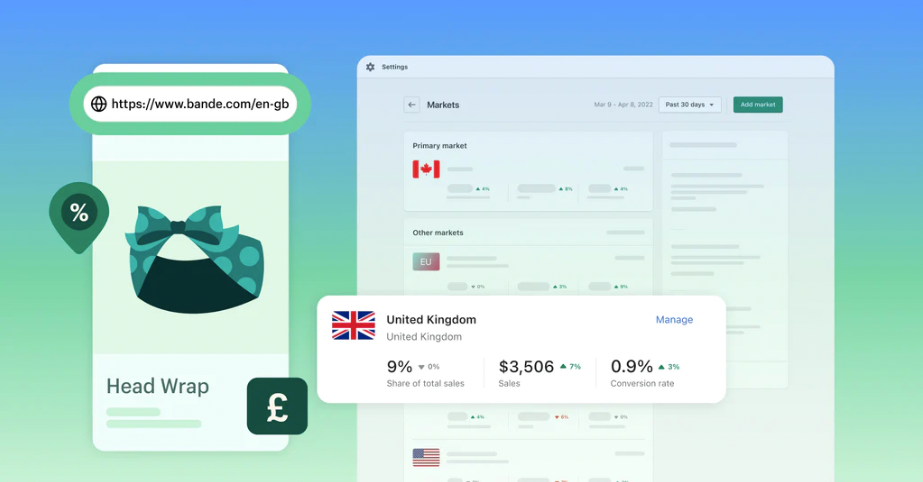Table of Contents
Get useful eCommerce stuff
Any eCommerce business should have global expansion in its growth strategy – it’s essential. International markets were already growing fast before the COVID-19 pandemic, but brick-and-mortar closures resulted in an unprecedented eCommerce boom. In 2022, the global eCommerce market is expected to total $5.55 trillion, and that figure is estimated to rise even more over the next few years.
China is currently outselling the world and, by 2024, is thought to make up more than 58 per cent of the global online retail market. China is followed by the United States, the second largest eCommerce market, then the UK, Japan, and South Korea. Things are growing exponentially, and these top five eCommerce markets are believed to remain unchanged until 2025.
While going global is a massive opportunity for your brand, it’s also one of the most complex challenges you will face as a merchant. There’s much more to it than just translating your online store into other languages to boost sales. It becomes narrowed down to customers' preferred payment currency - generally the one of their local country. It makes a business feel more reliable.
Thankfully, we’ve partnered with Shopify to provide a global platform built for scaling internationally, making diving into new markets sell more accessible and faster than ever.
In this article, we’ll show you how we can help you take your first steps towards expanding your brand internationally with Shopify and Blend.
Which markets should you target?
You will need to set your expansion goal and align your research with those goals to find out where you should expand. Analyse your current traffic and sales-by-country data, and you might even find that you’ve already gone global without knowing it.
You’ll then need to narrow your target by assessing the regional market potential for your business. You should understand the local market and how your brand could fit in, consider cultural differences, and consider the return on investment you could achieve.
A great way to validate new regions efficiently is to use global marketplaces such as Amazon, eBay, or China’s JD.com as testing grounds. You can tap into a vast, ready-made customer base (47 percent of global online sales happen on marketplaces), increase product visibility and brand awareness, and take advantage of the existing infrastructure and supply chain logistics.

When you add your Shopify store's products to be synchronised with JD Marketplace, the channel will automatically translate text, convert currency, and manage customs and taxes with foreign exchange rates already factored in.
Expand Your Store with Shopify
Once you’ve decided which countries you want to target, it’s time to prepare your eCommerce store for global expansion. You will need to consider many things, and it may be a challenge to wrap your head around some of them. First, how do you ensure customers see prices in their local currency? Also, should you focus on a single store, or does a multi-store approach suit your needs more?
Shopify's new Shopify Markets solution is one way to make it easy to sell to multiple countries. The cross-border management tool enables you to create tailored experiences for your customers with localised currencies, languages, domain names, and payment methods - which you can successfully manage from a single store. You will also gain access to a centralised dashboard that enables you to manage and optimise your global operations within the Shopify admin.

Shopify Markets lets you automatically convert your storefront prices to 130+ international currencies and rounds them up based on the latest foreign exchange rates.
You always want to ensure that your customers trust you; that they feel safe within your store. One way that Shopify Markets achieves this is by collecting duty and import taxes at checkout, which also ensures you, as a merchant, are compliant in each market you do business in. These regional variances, which also include fluctuating shipping prices, can make it difficult to determine the profit margins. Shopify Markets helps you control your pricing strategy by setting custom product prices per market.
Similarly, you can customise your fulfilment by market, which is especially useful when you have multiple warehouses in different regions worldwide. For example, if you have a US warehouse that ships exclusively to North America and a German warehouse that ships to Europe, European customers will only see the inventory in the German warehouse
Other options you might want to consider include using Shopify Plus’ nine expansion stores, partnering with a local reseller already established in the market you want to target, or launching a wholesale channel to reduce your risk and monitor local consumer demand.
Optimising the Global Customer Experience
Localisation is crucial in personalising your online store for international shoppers. To scale your global business, it’s vital that you offer them a frictionless and inclusive shopping experience wherever they are in the world.
You shouldn’t only focus on automating translations. At the very least, you should have experts check the translations, including visuals, for accuracy and cultural nuances, adapt clothing sizes and other measurements to the local region and tweak form fields so they accept international names and addresses that may include a unique character, umlaut or diacritic, or be written in a different script than the English alphabet.
Keep in mind that not everyone in the world reads left to right either, and offer customer support across different time zones, languages, and channels (which could even include a live chat with a native speaker). Customer service platforms like Gorgias can help you set up and scale customer support for multiple languages.
Meanwhile, monitoring shopping behaviour segmented by language or location is an excellent way to analyse what works and doesn’t work across your stores. This information will assist you in uncovering what prevents customers from completing their purchases, which you can then use to optimise future user experiences and design decisions.
If you’re aiming to go with the one-size-fits-all approach, be wary. Instead, go beyond the .com version of your website as the default domain extension for global businesses. You can use Shopify’s Geolocation app to automatically display your localised site to international visitors based on their IP address, location, and browser preferences. When they land on a .com site, for example, they will get redirected to a localised subdomain. Just another way of building trust with your customers and showing that you care.

Simplify Your Global Logistics & Cross-Border Shipping
Once expanding into new markets, you’ll want to make the fulfilment process as streamlined as possible for your customers and yourself. This can include establishing a supply chain with local manufacturing in your target region, setting up or leasing international warehouses, outsourcing part (or even all) or distributing fulfilment services for your business using something like the Shopify Fulfilment Network.
Bringing inventory closer to customers can be a concern. To do this, you can set up blended local checkout options like buy online, pick up in-store (BOPIS), or transform physical locations into shipping hubs by setting up simple local delivery programs. Both options are fully integrated within the Shopify admin and the Shopify POS app.
No matter what strategy you choose, each region will have its own rules and regulations that you’ll need to keep your eye on to optimise your operations and avoid any nasty surprises.
Setting You Up for International Success
International expansion has become an absolute necessity in today’s competitive environment. Standing out from the crowd is crucial in a world full of extraordinary thinkers to remove any barriers from your store and make it as profitable and efficient as possible.
Shopify is constantly improving its built-in features and introducing additional functionality to empower brands to sell internationally quickly. At the same time, many third-party apps can enhance the experience even further. At Blend, our designers, developers, marketers, and strategists stay updated with the latest developments and know how to get the most out of the platform.

Taking the Leap
Ready to go global yourself? It can be a real challenge to decide where you want to begin and what questions are the most important to solve for your specific brand.
As a dedicated Shopify Plus partner agency, we can advise you on which setup would best suit your business, which factors you need to consider to ensure the success of your international store, and how to prioritise them. Naturally, we’d also test your site to ensure everything works how it should work in the region (or regions) you are expanding to and, if necessary, fix any errors that could harm the customer experience.
If you’d like to explore all your options and take the leap, get in touch with us at Blend.








